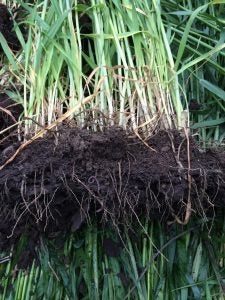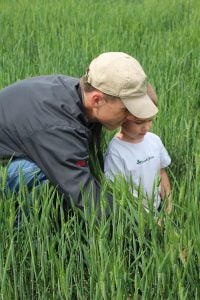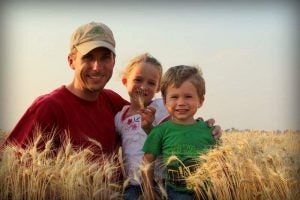It was one thing to be featured in the book, “Rancher, Farmer, Fisherman: Conservation Heroes of the American Heartland.” It was quite another to be featured in the film. But it was something fifth-generation farmer Justin Knopf just had to do.
“As I thought about it and discussed it with my family, I ended up going back to the same reasons I chose to share our story for the book, and my sense was that the folks behind the project had pure intentions and genuine interest to understand and portray this story in a meaningful and accurate way,” Knopf said.
Knopf’s story, along with three others whose conservation practices challenge widely-held beliefs about sustainability and farming, will be shared nationwide at 9 p.m. ET Thursday, Aug. 31, when the Discovery Channel airs “Rancher, Farmer, Fisherman.”
Based on Miriam Horn’s recently released book, “Rancher, Farmer, Fisherman” first debuted in the prestigious Documentary Premieres Section at the 2017 Sundance Film Festival. Narrated by Emmy and Peabody winning journalist Tom Brokaw, and directed by Emmy-winning and Oscar-nominated filmmaker Susan Froemke and Emmy-winning filmmaker John Hoffman, “Rancher, Farmer, Fisherman” weaves together the stories of four unlikely conservation heroes working in America’s heartland.
One of those heroes just happens to be Knopf, a husband and father of three who farms 4,500 acres in central Kansas, producing wheat, soy, sorghum, and alfalfa. While some may consider Knopf ‘big ag,’ his commitment to conservation challenges the stereotypes of environmentalists.
“The way we think about our farm is very different with a no-till based system vs a tillage-based system,” Knopf said. “A no-till based system is based much more on biological relationships, many of which we cannot see. However, building our foundation on the biological relationships yields a more resilient farming system.”
Knopf made the switch to no-till on his family’s farm after learning more about the foundational aspects of soils — soil structure, water infiltration, microbiology, and other important characteristics — while an agronomy student at Kansas State. Another significant event for Knopf’s decision came from a student road trip to Dakota Lakes Research farm in South Dakota to see the work Dr. Duane Beck was already implementing.
“As I began to understand the importance of these soil characteristics, it became more apparent that a tillage-based system would not take us in the direction we wanted our farm to go in the long run, which was towards restoration and improved productivity and resiliency for the next generation,” Knopf said.

It also helped the young grad’s family was open to change.
“My brother was on the same page as me as to the direction we wanted to move and we are very fortunate to farm with a father who has always placed a tremendous amount of trust in us and allowed us to lead,” Knopf said. “He of course had some very appropriate questions, but was very supportive in the transition and now very thankful we made the transition.”
The switch to no-till hasn’t been easy. Knopf has picked up tips from other farmers who have had success as well as at the annual No-Till on the Plains winter conference in Salina, Kansas.
Knopf said it also helps having enduring patience and practicing constant observation. After all the best place to learn has been his own fields.

“Spending time during each season of the year in our fields with a spade and observing what’s happening and changing with things such as soil structure, earthworm activity, water infiltration and holding capacity, and plant rooting characteristics is where I learn and can see the outcomes of our management choices,” Knopf said. “I consider our fields my classroom and it’s the ongoing, careful observations of the smallest details to the broader landscape that help me learn from mistakes and also from victories.”
And it’s paying off. His fields are holding soil, water and nutrients in place and building organic matter, fertility, and biodiversity. Dr. Ray Ward, a soil scientist from Nebraska has charted Knopf’s soil progress in total mass, diversity, and vigor. His soil carbon, depleted to near zero by generations of plowing, is now more than halfway to the 4 percent carbon levels in native prairie soils.
Knopf admits he’s still trying to get a handle on cover crops, but after several years’ observation he has seen a number of agronomic benefits. Their winter cereal cover crop ahead of soybeans is reducing weed pressure, particularly from marestail and pigweed, two very significant weeds. He has also observed more earthworm presence and activity when covers are utilized. During the 105+ degree heat in July this summer, the two inch soil temp in a soybean field with cover ahead of it topped out at 90 degrees Fahreheit. An adjacent soybean field with no residue under the canopy measured over 100. Another significant benefit has been increased residue and soil protection during phases of rotation that can tend to get too low on residue cover.
“We are not planting cover crops on every field, but the acreage we are utilizing them on is increasing and we are continuing to experiment and learn about where they might fit or might not fit in our system,” Knopf said. “We don’t have any cattle to graze either, which would be an excellent partner to cover crops, so we are also watching our costs and trying to get the most agronomic benefit per dollar as we design what mixes we are using.”
His future plans for the farm are pretty simple: continue to observe, learn, and adapt to change.

“Resiliency, stewardship, and regenerative practices will be foundational themes. As our kids get older, they will become more involved on the farm if they so choose,” Knopf said. “We will hope to instill in them the value of stewardship along with a long-term perspective that is larger than ourselves.”
It’s those same values Knopf hopes to share with viewers Thursday night when they watch “Rancher, Farmer, Fisherman.”
“First, I feel it’s an increasingly rare opportunity to be a farmer and work with God’s creation on a daily basis alongside my family. Second, our society is ever more removed from the farm yet more interested and concerned about where their food comes from and the practices involved in producing that food,” Knopf said. “With that perspective, I feel a responsibility to share our story about the values that are important to our family and how they shape the way we farm.”
Even though filming “Rancher, Farmer, Fisherman” was lengthy and was uncomfortable at times, Knopf said he is glad he took the risk and hopes that his small story is meaningful and resonates in some way with those who watch.
“You know, I hope people will have a renewed sense of optimism. Those of us featured in this project have a few things in common,” Knopf said. “We’re all deeply tied and connected to the places and the landscapes that we work in daily. Our families and livelihoods depend on natural resources that are equally vital and important to the rest of the world. We have long-term perspective and recognize the decisions we make today will impact future generations. And I hope they realize those of us featured in this project are not that incredibly different than many of our neighbors and colleagues.”



